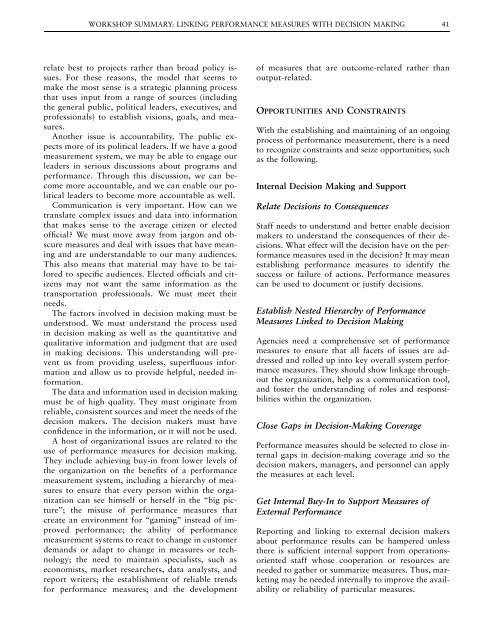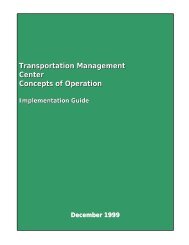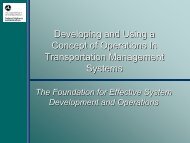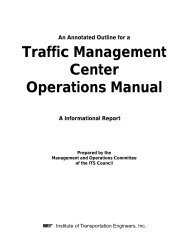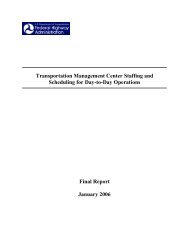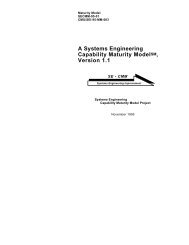Conference Proceedings 26 - Transportation Research Board
Conference Proceedings 26 - Transportation Research Board
Conference Proceedings 26 - Transportation Research Board
- No tags were found...
You also want an ePaper? Increase the reach of your titles
YUMPU automatically turns print PDFs into web optimized ePapers that Google loves.
WORKSHOP SUMMARY: LINKING PERFORMANCE MEASURES WITH DECISION MAKING 41relate best to projects rather than broad policy issues.For these reasons, the model that seems tomake the most sense is a strategic planning processthat uses input from a range of sources (includingthe general public, political leaders, executives, andprofessionals) to establish visions, goals, and measures.Another issue is accountability. The public expectsmore of its political leaders. If we have a goodmeasurement system, we may be able to engage ourleaders in serious discussions about programs andperformance. Through this discussion, we can becomemore accountable, and we can enable our politicalleaders to become more accountable as well.Communication is very important. How can wetranslate complex issues and data into informationthat makes sense to the average citizen or electedofficial? We must move away from jargon and obscuremeasures and deal with issues that have meaningand are understandable to our many audiences.This also means that material may have to be tailoredto specific audiences. Elected officials and citizensmay not want the same information as thetransportation professionals. We must meet theirneeds.The factors involved in decision making must beunderstood. We must understand the process usedin decision making as well as the quantitative andqualitative information and judgment that are usedin making decisions. This understanding will preventus from providing useless, superfluous informationand allow us to provide helpful, needed information.The data and information used in decision makingmust be of high quality. They must originate fromreliable, consistent sources and meet the needs of thedecision makers. The decision makers must haveconfidence in the information, or it will not be used.A host of organizational issues are related to theuse of performance measures for decision making.They include achieving buy-in from lower levels ofthe organization on the benefits of a performancemeasurement system, including a hierarchy of measuresto ensure that every person within the organizationcan see himself or herself in the ‘‘big picture’’;the misuse of performance measures thatcreate an environment for ‘‘gaming’’ instead of improvedperformance; the ability of performancemeasurement systems to react to change in customerdemands or adapt to change in measures or technology;the need to maintain specialists, such aseconomists, market researchers, data analysts, andreport writers; the establishment of reliable trendsfor performance measures; and the developmentof measures that are outcome-related rather thanoutput-related.OPPORTUNITIES AND CONSTRAINTSWith the establishing and maintaining of an ongoingprocess of performance measurement, there is a needto recognize constraints and seize opportunities, suchas the following.Internal Decision Making and SupportRelate Decisions to ConsequencesStaff needs to understand and better enable decisionmakers to understand the consequences of their decisions.What effect will the decision have on the performancemeasures used in the decision? It may meanestablishing performance measures to identify thesuccess or failure of actions. Performance measurescan be used to document or justify decisions.Establish Nested Hierarchy of PerformanceMeasures Linked to Decision MakingAgencies need a comprehensive set of performancemeasures to ensure that all facets of issues are addressedand rolled up into key overall system performancemeasures. They should show linkage throughoutthe organization, help as a communication tool,and foster the understanding of roles and responsibilitieswithin the organization.Close Gaps in Decision-Making CoveragePerformance measures should be selected to close internalgaps in decision-making coverage and so thedecision makers, managers, and personnel can applythe measures at each level.Get Internal Buy-In to Support Measures ofExternal PerformanceReporting and linking to external decision makersabout performance results can be hampered unlessthere is sufficient internal support from operationsorientedstaff whose cooperation or resources areneeded to gather or summarize measures. Thus, marketingmay be needed internally to improve the availabilityor reliability of particular measures.


